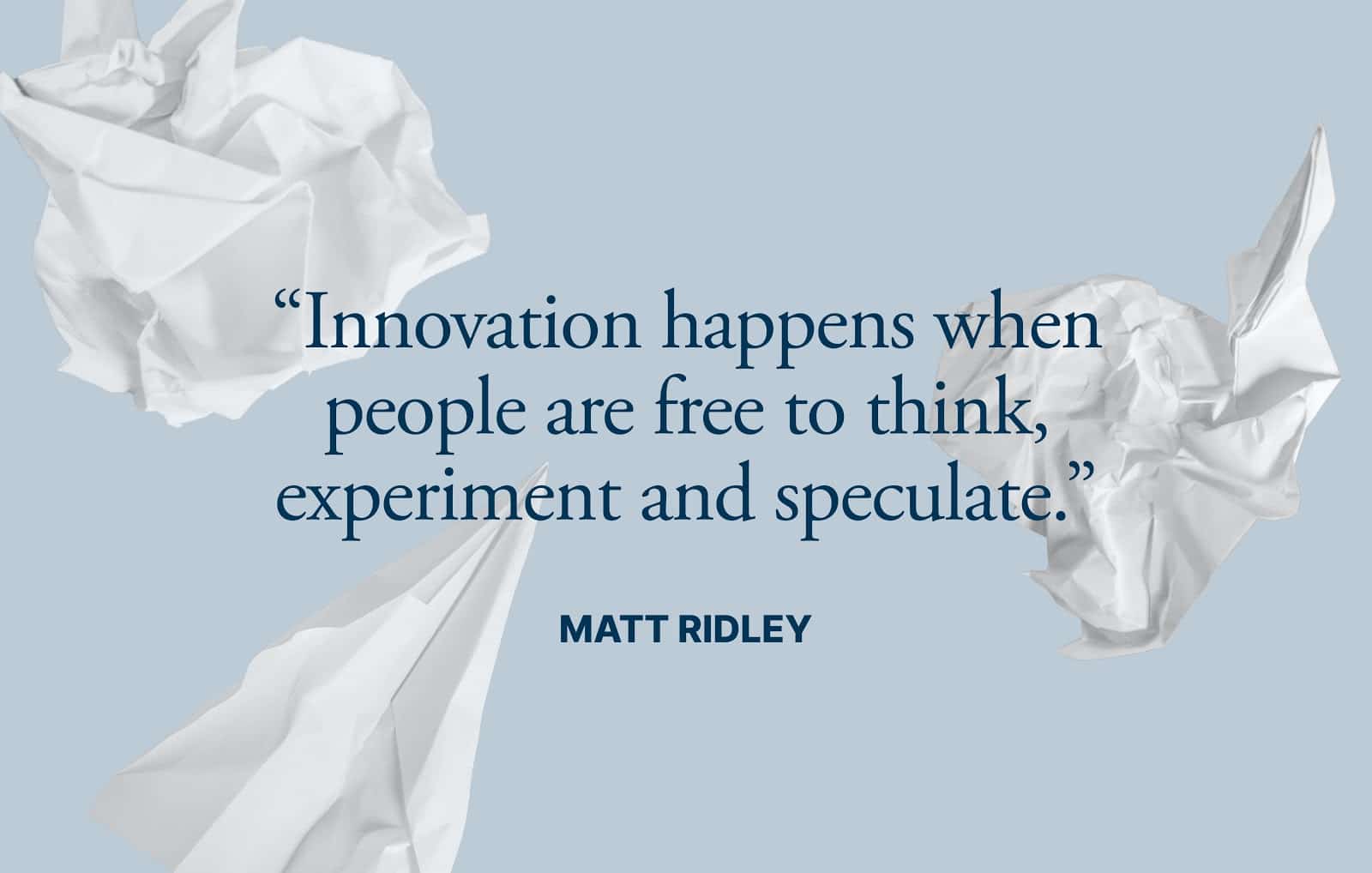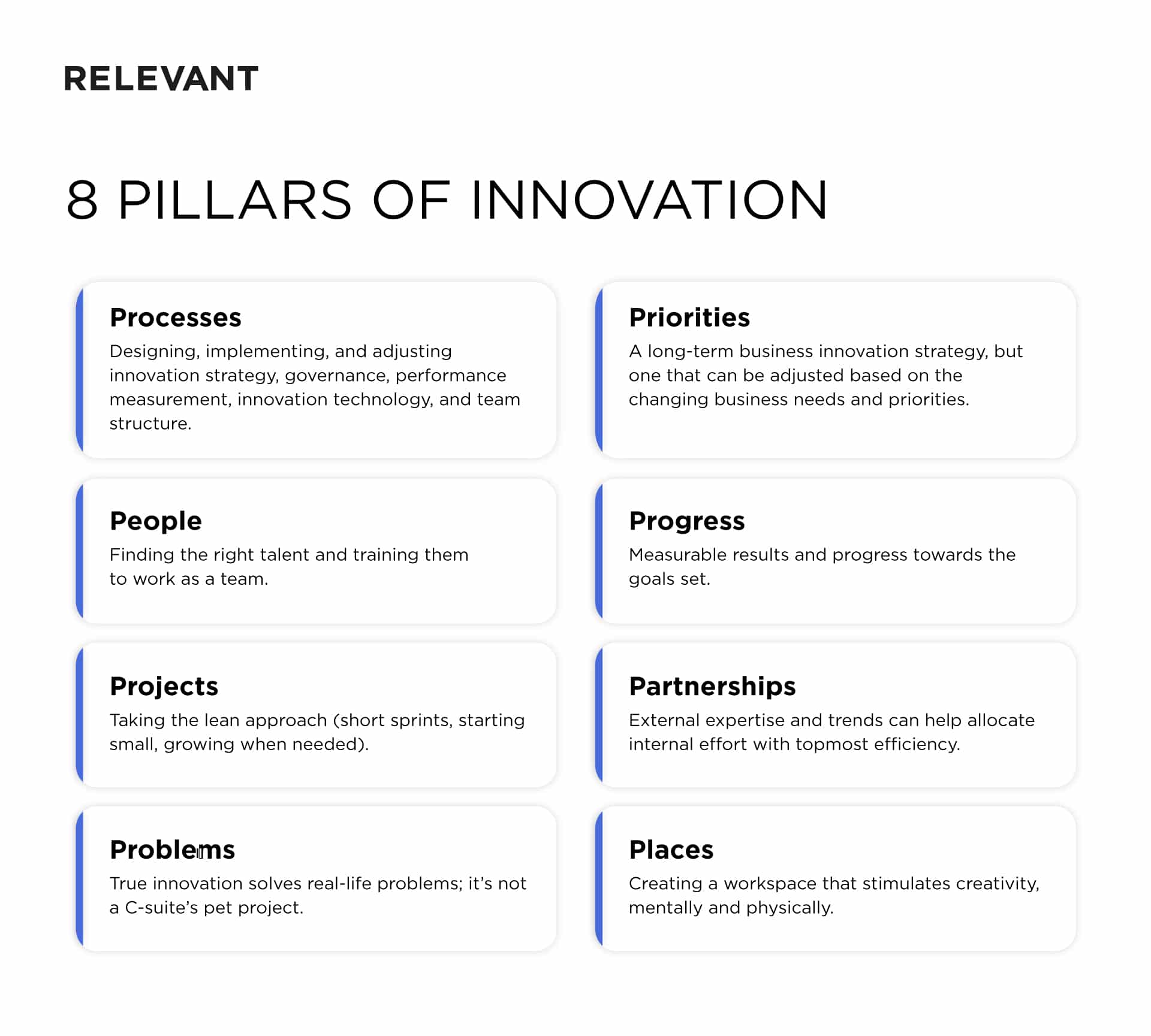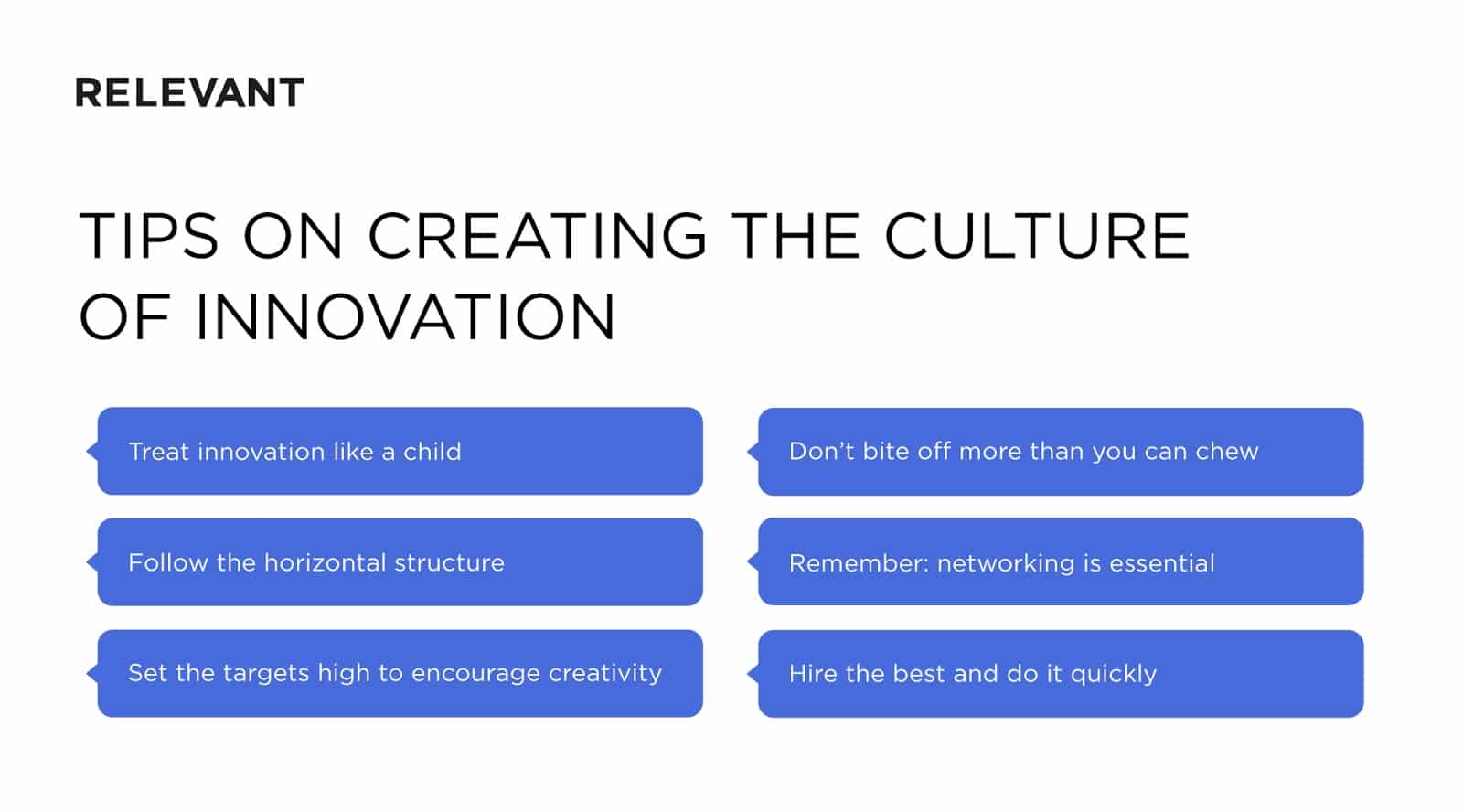Creating the Innovation Culture and Why It’s Important Today
Updated: July 17, 2021
Let’s be honest: without an active innovation culture, organizations fall into stagnation and lose to more innovative competitors. You know this all too well if you work for a corporate business that strives to compete with the likes of Tesla, Airbnb, or Uber. Every industry has startups like these, and they’re on a roll. The services and products they provide are not too different from those you offer — but why do they outperform established corporations?
Because these startups leverage the benefits of the continuous innovation culture, which helps them make decisions faster, select the most appropriate executors and toolsets for every task, implement processes, and adjust them based on feedback. Let’s take a look at the notion of the innovation culture and how it can apply to your business.

We provide companies with senior tech talent and product development expertise to build world-class software. Let's talk about how we can help you.
Contact us
Table of Contents
What Leaders Should Know About the Culture of Innovation
The culture of innovation boils down to perceiving creativity as a virtue, not a nuisance. It’s the freedom to express your ideas, regardless of how little experience you have, because there can be a seed of solution in a fresh look at the problem.
Sadly, though, we mostly see enterprises where employees are in a never-ending battle to meet the quarterly goals and keep the team motivated to do the same thing the same way, over and over again. Burnouts, loss of interest in self-development, passiveness are just some of the traits of the managerial body in large companies. And the larger the business, the bigger the scale of the problem. After all, it’s much safer to follow instructions than suggest new ideas and risk them becoming empty expenses.
Besides — and let’s be honest with ourselves here — while many companies state they are innovative, or at least assert the importance of innovation, few invest enough effort into it. Becoming innovative requires C-level executive buy-in, reallocation of resources within the company, updating processes, schedule adjustments, and a lot of daily work that doesn’t bear immediate fruit. That is why so many companies take their innovation culture initiatives halfheartedly or drop them along the way.
However, there are time-proven criteria and reliable tools that can help establish the culture of innovation in any organization large or small, foster this business innovation endeavor, and turn it into a driving force that will help your company stay ahead of competitors. Learning this information will help you become the transformational and innovative leader your company needs to survive and succeed long-term.
8 Pillars of Innovation
The first thing to understand is that innovation isn’t a one-time project — it is a continuous effort built of eight aspects, the so-called eight P-illars of the innovation culture:
- Processes. Designing, implementing, and adjusting innovation strategy, governance, performance measurement, innovation technology, and team structure.
- People. Finding the right talent and training them to work as a team.
- Projects. Taking the lean approach (short sprints, starting small, growing when needed).
- Problems. True innovation solves real-life problems; it’s not a C-suite’s pet project.
- Priorities. A long-term business innovation strategy, but one that can be adjusted based on the changing business needs and priorities.
- Progress. Measurable results and progress towards the goals set.
- Partnerships. External expertise and trends can help allocate internal effort with topmost efficiency.
- Places. Creating a workspace that stimulates creativity, mentally and physically.

Here’s how each of these components contributes to making your organization more innovative.
Processes
It’s hard to start innovating without previous experience. Innovation means changes, and executives fear that these changes may be for the worse. This is why building the right processes is essential: having the structure and strategy written down helps to ensure your efforts don’t go to waste.
People
The team is your greatest asset. But it’s not about headcount; it’s about motivation and dedication. To innovate, you need to attract external experts who’ve done it already and engage internal talents ready to give new ways and ideas a try. Find the right people both inside and outside your team and start rolling.
Projects
It’s impossible to do something new in an old way. You need to reform the project management approach from the start. Instead of planning the whole project at once, you need to start small, form lean teams (external + internal talents), work in short sprints, and build working processes before scaling them to the whole organization.
Problems
You need to ensure you get the most revenue possible with the biggest cost-efficiency. This means business innovation must be centered around the most pressing matters for your company, not some pivots or pet projects. Otherwise, it won’t get enough engagement from the team.
Priorities
The bigger the company, the more problems it has to solve. It means there can be multiple areas to apply your effort to, and setting the priorities straight is one of the hardest steps of innovation. The best way to approach this is by forming an innovative thesis and sharing it with the managerial body across the company to make sure your innovative initiatives are aligned with the long-term company strategy. The stakeholders must see how doing things the new way will provide them with better results.
Progress
Setting measurable KPIs and tracking how your efforts push the company toward the desired goal is essential to get executive buy-in and confidence. Confidence means trust, and it comes with more resources, fewer approvals, faster processing of your requests, etc. This, in turn, leads to more rapid progress and more value delivered.
Partnerships
The biggest roadblock for many enterprises is the need to admit they cannot innovate on their own. It’s hard to believe that organizations with a lengthy record of mergers and acquisitions can be so stubborn in terms of forming partnerships with startups, external technology vendors, or research centers and universities. However, once the idea gets adopted, the pace of learning and training your team becomes much faster, and so does the transformation speed.
Places
This aspect of innovation includes both physical and mental spaces. Strict offices with tiny cubicles weren’t designed to foster innovation and creativity. Take a look at the co-workings and innovative areas of other successful enterprise innovators. They have open spaces with bean bags, post-it walls, motivating quotes everywhere — areas where people feel equal and it’s easier to suggest new ideas.
However, it’s important to primarily build such spaces inside the heads of your coworkers by emphasizing that the innovation culture is all about trying, failing, and trying something else until it works.
These eight pillars of innovation are essential, but they require decent management tools to get moving and deliver value.
Read about employee time tracking software development.
Top 5 Innovation Management Tools
Gartner provides a comprehensive list of innovation management tools covering such aspects as ideation, tracking of implementation, and results monitoring on various project phases. We listed the top five innovation management tools based on customer reviews.
Planview from Spigit
Planview is the top-end enterprise innovation management platform from Spigit. It offers extensive functionality and a vast variety of configuration options, allowing every customer to adjust it to their needs. The vendor provides ample onboarding and rollout assistance, knowledge base, training, and customer support. This resulted in 4.2 out of 5 stars, based on 17 reviews.
But there are downsides. Even the bare bones of the functionality take multiple hours to master, and you will need to invest several months to get everything configured the way your particular company needs.
Ideadrop
Ideadrop provides a centralized idea governance platform that helps store, structure, and manage ideas from all stakeholders and team members, enable open discussions, and reduce the feedback loop. It’s quite easy to use, and the vendor possesses strong technical expertise in the innovation governance field.
The downsides of using Ideadrop include the somewhat long deployment and onboarding (up to six months) due to the in-depth configuration and a steep learning curve.
Itonics Enterprise
This solution is centered around increasing business agility, enhancing the decision-making process, and driving innovation across complex portfolios of organizations. While the off-the-shelf solution does not boast rich functionality, Itonics has quite a large number of integrations, and the vendor performs custom adjustments quite quickly. Itonics can be customized to meet the needs of any enterprise, allowing the product to become an integral decision-making part of any modern company.
The main potential downside of Itonics is the danger of lousy configuration due to miscommunication, so make sure your specs are precise. Otherwise, you risk investing in custom functionality you don’t need.
Brightidea Innovation Platform
This product provides integration with Active Directory, which is absolutely essential for global enterprises. It is very simple to use, and end-users need minimal training to start adding, tracking and managing their innovation initiatives and campaigns. This makes it an excellent choice for geographically distributed companies where staff training requires a lot of investment.
The biggest potential drawback of this platform is how long and complicated the initial integration and configuration are – up to nine months. However, the vendor provides in-depth help content and diligent technical support.
HYPE Enterprise
HYPE has proven to be a tool centered around capturing and cultivating ideas from inception to value. Customizable on both the front end and the back end, this platform can adapt to the needs of every organization. The vendor’s team is very customer-oriented, yet the full customization and implementation of the platform can take up to nine months.
The main downside of working with HYPE is its feature-richness and the lack of templated pipelines, so building the processes that work for your organization might require lots of trial and error and intense collaboration with the support center. However, the platform is being actively developed, and all customer feedback is noted.
Tips on Creating the Culture of Innovation
When you get all the basics covered and select the appropriate tools to oversee and govern your innovation culture, the final question remains: how can you keep innovating consistently without losing focus? Here are some tips from Revenant Software that will be useful in doing just that.
Treat innovation like a child
Treat the business innovation culture like a child: set strict limits, but let it play the way it wants. Innovation should be based on the overall organizational objectives, core capabilities, and focus areas, customer-centric services, and commitments to stakeholders. However, it should not be limited by budgets, deadlines, and micromanagement.
The innovators in your organization must understand what’s expected of them — delivering practical products and solutions that can be replicated and scaled affordably. But you should let them pursue their own approaches, make their own mistakes, and gain their own experience.
Follow the horizontal structure
Great ideas need to be conveyed to executives immediately – without intermediaries, or they risk dying along the way. If you want your company to become truly innovative, booking a meeting with an executive to discuss an idea should require no more effort than planning a lunch with a colleague.
Set the targets high to encourage creativity
When the scope of work is set higher, people start thinking outside the box, and instead of optimizing the existing routines, they can suggest a complete reconfiguration of the process, which can yield an efficiency increase that’s higher than you needed in the first place.
Don’t bite off more than you can chew
A company can indeed starve without new ideas. The contrary is also true — spreading thin to deliver dozens of projects can never yield tangible benefits. Your innovators must have two projects maximum on their hands, so they can switch back and forth if any roadblocks arise. But having over three projects will mean they won’t be able to concentrate on any of them effectively.
Remember: networking is essential
Your executives and employees should build external networks and partnerships in communities, conferences, and other knowledge exchange events. If they know many like-minded people, they can combine input from many of them and introduce better ideas.
Hire the best and do it quickly
Creative people don’t grow on trees, but they spring in startup incubators, university graduations, or hackathons. Maintaining good relations with universities allows you to get to know the best graduates. Grab them fast!
You can also hire ready teams from software development vendors to get instant access to a pool of talents that know how to build the business innovation culture from scratch. Such investments are likely to pay off very well.

How Relevant Can Help You Innovate
The innovation culture can be built like any other approach or initiative, but it cannot be bought like a product. Yes, it takes time, the constant engagement of all the parties involved, and investment of efforts and resources. But developing and nurturing the innovation culture is essential for the long-term survival of any organization that wishes to remain competitive in the fast-paced business world of the 21st century.
Ensure the eight pillars of innovation are present in your company and select the innovation management tool that meets your case best. Combine knowledge and approaches from creative employees and external experts. Put effort into restlessly fostering innovation and adjust as needed to maintain focus on the goal, instead of getting lost in procedures. And if you need help, we’re here for you.
Relevant helps tech companies and businesses innovate through technology, by providing workshops and brainstorming sessions, business analysis, and software development services. Contact us, and let’s transform your company together!
Our core services:
Do you want a price estimate for your project?
Do you know that we helped 200+ companies build web/mobile apps and scale dev teams?
Let's talk about your engineering needs.
Write to us











